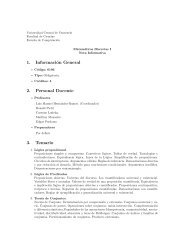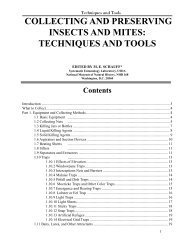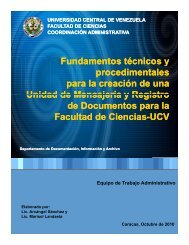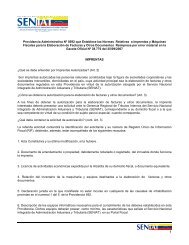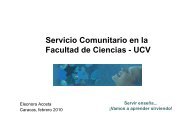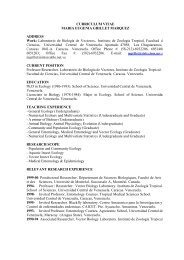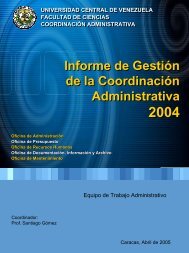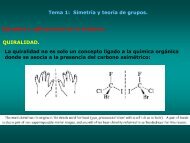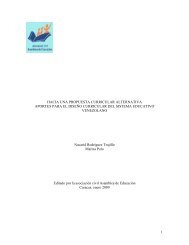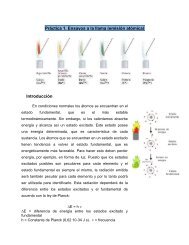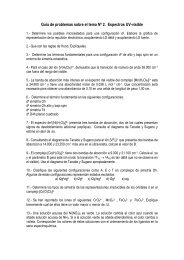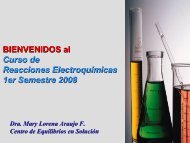Loop-mediated isothermal amplification test for Trypanosoma vivax ...
Loop-mediated isothermal amplification test for Trypanosoma vivax ...
Loop-mediated isothermal amplification test for Trypanosoma vivax ...
- No tags were found...
You also want an ePaper? Increase the reach of your titles
YUMPU automatically turns print PDFs into web optimized ePapers that Google loves.
G ModelVETPAR-5767; No. of Pages 5ARTICLE IN PRESSVeterinary Parasitology xxx (2011) xxx–xxxContents lists available at ScienceDirectVeterinary Parasitologyjournal homepage: www.elsevier.com/locate/vetparShort communication<strong>Loop</strong>-<strong>mediated</strong> <strong>isothermal</strong> <strong>amplification</strong> <strong>test</strong> <strong>for</strong> <strong>Trypanosoma</strong> <strong>vivax</strong>based on satellite repeat DNAZ.K. Njiru a,∗ , J.O. Ouma b , R. Bateta b , S.E. Njeru b , K. Ndungu b , P.K. Gitonga b ,S. Guya b , R. Traub aa School of Veterinary Sciences, University of Queensland, Gatton, QLD 4343, Australiab Trypanosomiasis Research Centre, Kenya Agricultural Research Institute, P.O. Box 362-00902, Kikuyu, KenyaarticleinfoabstractArticle history:Received 15 January 2011Received in revised <strong>for</strong>m 10 March 2011Accepted 11 March 2011Keywords:<strong>Loop</strong>-<strong>mediated</strong> <strong>isothermal</strong> <strong>amplification</strong><strong>Trypanosoma</strong> <strong>vivax</strong>NaganaTrypanosomiasisPCR<strong>Trypanosoma</strong> <strong>vivax</strong> is major cause of animal trypanosomiasis and responsible <strong>for</strong> enormouseconomic burden in Africa and South America animal industry. T. <strong>vivax</strong> infections mostly runlow parasitaemia with no apparent clinical symptoms, making diagnosis a challenge. Thiswork reports the design and evaluation of a loop-<strong>mediated</strong> <strong>isothermal</strong> <strong>amplification</strong> (LAMP)<strong>test</strong> <strong>for</strong> detecting T. <strong>vivax</strong> DNA based on the nuclear satellite repeat sequence. The assay israpid with results obtained within 35 min. The analytical sensitivity is ∼1 trypanosome/mlwhile that of the classical PCR <strong>test</strong>s ranged from 10 to 10 3 trypanosomes/ml. The T. <strong>vivax</strong>LAMP <strong>test</strong> reported here is simple, robust and has future potential in diagnosis of animaltrypanosomiasis in the field.© 2011 Elsevier B.V. All rights reserved.1. Introduction<strong>Trypanosoma</strong> <strong>vivax</strong> is a widely distributed parasite anda major pathogen of ruminants in sub-Saharan Africa andSouth America. In Africa, it is predominantly transmittedcyclically by tsetse flies and to a lesser extent by bitingflies while in South America it is mechanically transmittedby blood-sucking flies such as tabanids and stableflies (Wells, 1984; Meléndez et al., 1993). T. <strong>vivax</strong> is economicallyimportant because it causes mortality and highmorbidity in ruminant livestock. Different patterns of diseaseoccur in Africa and South America; in South Americathe disease occurs in cattle as epizootics and with rare outbreaks(Osório et al., 2008) while in Africa the disease runsa more severe and acute <strong>for</strong>m (Stephen, 1986). A few EastAfrican isolates of T. <strong>vivax</strong> cause an acute hemorrhagic syn-∗ Corresponding author at: School of Veterinary Sciences, Universityof Queensland, Inner Ring Road, Blgd 8114, RM 231, Gatton, QLD 4343,Australia. Tel.: +61 7 5460 1973.E-mail addresses: zablon@iprimus.com.au, z.njiru@uq.edu.au(Z.K. Njiru).drome with a mortality rate of 6–35% (Assoku and Gardiner,1989; Magona et al., 2008).The definition of accurate geographical endemicity ofT. <strong>vivax</strong> has been limited by the ease in which variety ofinsect vectors (some yet to be identified) transmits theparasite (Masake et al., 1997). As such the most definitiveway of verifying the presence of the parasite is throughits detection in the host and to a lesser extent in vectors.Detection of T. <strong>vivax</strong> in animals is a challenging tasksince infection runs typically a low parasitaemia limitingthe use of parasitological techniques such as microscopyin the field diagnosis (Nantulya, 1990). These drawbacksled to development of antibody based techniques such asantibody indirect fluorescent staining technique (Platt andAdams, 1976) and enzyme-linked immunosorbent assays(ELISA) (Luckins, 1977; Nantulya, 1990; Ferenc et al., 1990).The persistence of antibodies in the host after treatmentimplied that these antibody detecting <strong>test</strong>s could not differentiatebetween past and current infection. To overcomethe limitation imposed by the antibody assays, an antigenbased ELISA was developed (Nantulya et al., 1992) but itsdiagnostic parameters in the field were not encouraging0304-4017/$ – see front matter © 2011 Elsevier B.V. All rights reserved.doi:10.1016/j.vetpar.2011.03.021Please cite this article in press as: Njiru, Z.K., et al., <strong>Loop</strong>-<strong>mediated</strong> <strong>isothermal</strong> <strong>amplification</strong> <strong>test</strong> <strong>for</strong> <strong>Trypanosoma</strong> <strong>vivax</strong>based on satellite repeat DNA. Vet. Parasitol. (2011), doi:10.1016/j.vetpar.2011.03.021
G ModelVETPAR-5767; No. of Pages 5ARTICLE IN PRESS2 Z.K. Njiru et al. / Veterinary Parasitology xxx (2011) xxx–xxx(Desquesnes, 1996). Molecular based <strong>test</strong> (PCR) promisedbetter sensitivity and a range of them were developed(Masiga et al., 1992; Masake et al., 1997; Morlais et al.,2001) but the demanding nature of PCR technique has limitedits use in routine diagnosis. Nevertheless due to lowparasitaemia and difficulties in propagating T. <strong>vivax</strong> in mice,PCR has remained the most appropriate method <strong>for</strong> laboratorybased diagnosis (Jones and Dávila, 2001). To datea definitive field based assay <strong>for</strong> T. <strong>vivax</strong> has been elusive,there<strong>for</strong>e it is essential to continue evaluating newdiagnostic technologies and especially those that offer plat<strong>for</strong>ms<strong>for</strong> developing point of use <strong>test</strong>s.<strong>Loop</strong>-<strong>mediated</strong> <strong>isothermal</strong> <strong>amplification</strong> (LAMP) is anovel gene <strong>amplification</strong> method that amplifies DNA under<strong>isothermal</strong> conditions (Notomi et al., 2000). The techniqueuses four to six primers that recognize six to eight regionsof the target DNA and relies on Bst DNA polymerase, anenzyme that synthesizes DNA through strand displacementactivity. The LAMP method has several advantages over PCRin that: (i) LAMP <strong>amplification</strong> can be achieved using simpleheating device that maintains temperature at <strong>isothermal</strong>(60–65 ◦ C), (ii) <strong>amplification</strong> can be achieved using partiallyor non-processed template (Kaneko et al., 2007; Njiruet al., 2008) there<strong>for</strong>e DNA extraction may not be necessary,(iii) reactions are rapid and require shorter time (Nagamineet al., 2002), (iv) sensitivity is equal or higher than that ofPCR and (v) the technology allows the use of varied productdetection <strong>for</strong>mats. These characteristics make LAMP strategyideal <strong>for</strong> T. <strong>vivax</strong> diagnosis in resource poor endemicregions. In this study, we have designed a rapid T. <strong>vivax</strong>LAMP <strong>test</strong> based on the satellite repeat DNA. The nuclearsatellite repeat sequence is a desired target because it ismulticopy gene and widely conserved among T. <strong>vivax</strong> isolatesin Africa and S. America. The <strong>test</strong> was evaluated andcompared with PCR <strong>test</strong>s using a panel of T. <strong>vivax</strong> isolatesand archived field samples.2. Materials and methods2.1. Preparation of templateA total of 23 T. <strong>vivax</strong> samples collected from Kenya,Uganda, Tanzania and Nigeria from bovine and tsetseflies between 1951 and 1991 were used in this study.The samples included three hemorrhagic T. <strong>vivax</strong> samplesfrom Kenya. The DNA was prepared using the QiagenDNeasy blood and tissue kit and following the manufacturerinstructions. The resulting DNA was stored at −20 ◦ C.2.2. Polymerase chain reactionThe PCR <strong>test</strong> reactions <strong>for</strong> satellite repeat DNA (Masigaet al., 1992) and diagnostic antigen gene (Masake et al.,1997) were done using the published conditions. A thirdPCR <strong>for</strong> satellite repeat DNA was per<strong>for</strong>med using outer<strong>for</strong>ward (F3) and backward (B3) LAMP primers. The newPCR <strong>test</strong> was per<strong>for</strong>med using a 25 l reaction consistingof 1× PCR buffer, 200 M of each dNTP, 1.5 mM of MgCl 2 ,12.5 pmol of each F3 and B3 primers, 1 U Taq DNA Polymerase(Fisher Biotec, WA, Australia) and 1-l of DNAtemplate. The reactions were done in duplicates using a96-Well GeneAmp ® PCR System 9700 (Applied Biosystems,Australia) at: 1 cycle 95 ◦ C <strong>for</strong> 10 min, followed by 40 cyclesof 94 ◦ C <strong>for</strong> 45 s, 63 ◦ C <strong>for</strong> 30 s and 72 ◦ C <strong>for</strong> 30 s and a finalextension at 72 ◦ C <strong>for</strong> 10 min. After <strong>amplification</strong>s, 10-lofthe PCR products were resolved <strong>for</strong> 70 min in 2.0% agarosegel stained with SYBR ® safe DNA gel stain (Invitrogen, Victoria,Australia). The gel images were documented usingGel- Doc-XR system (Bio-Rad Lab).2.3. LAMP primers and reactionT. <strong>vivax</strong> satellite repeat DNA (Accession number J03989)was used <strong>for</strong> designing six LAMP primers. The primerswere <strong>for</strong>ward and backward primers: F3 = TGTTCTGGTGG-CCTGTTGC and B3 = GGCCGGAGCGAGAGGTGC, <strong>for</strong>wardand backward inner primers: FIP = GTGGAGCGTG-CCAACGTGGCACCCGCTCCCAGACCATA and BIP = TGTCT-AGCGTGACGCGATGGAAGAGGGAGTGGGGAAGG and loop<strong>for</strong>ward and backward primers: CACATGGAGCATCAGGACand LB: CCGTGCACTGTCCCGCAC. The LAMP <strong>test</strong>s werecarried out in 25-l reactions consisting of 5 pmol ofthe outer primers, 20 pmol of loop primers, 40 pmol ofthe inner primers, 4 mM of extra MgSO 4 , 1 M betaine(Sigma–Aldrich, St. Louis, MO, USA) and 2.5 mM deoxynucleotidetriphosphates mix (dNTP). The 1× ThermoPolreaction buffer contained 20 mM Tris–HCl (pH 8.8), 10 mMKCl, 10 mM (NH 4 ) 2 SO 4 , 2 mM MgSO 4 and 0.1% TritonX-100. The Bst DNA polymerase (Large fragment; NewEngland Biolabs, MA, USA) was 1 l (8 units) while SYTO-9fluorescence dye at 1.5 M (Molecular Probes, OR USA)was used <strong>for</strong> each real time reaction. The template was1-l (∼1 ng) of T. <strong>vivax</strong> isolate EATRO 1186. The mixturewas incubated at 63 ◦ C in the Rotor-Gene 6000 (Qiagen,Victoria, Australia) and data acquired on HRM channel(460–510 nm) followed by reaction inactivation at 80 ◦ C<strong>for</strong> 4 min. Later the assay was trialed using a normal waterbath. Briefly, water was heated to ∼63–64 ◦ C and the LAMPreaction tubes suspended in water using a floater <strong>for</strong> 1 h,after which the temperature was raised to approximately80 ◦ C to stop the reactions. To select an appropriaterestriction enzyme <strong>for</strong> product analysis, the targetsequence was analyzed using restriction enzyme mapperin DNAman software (Lynnon Corporation, Quebec,Canada).2.4. Detection and confirmation of LAMP productThe LAMP reactions were monitored in real timethrough fluorescence of double stranded DNA (dsDNA) inRotor-Gene 6000. After <strong>amplification</strong>, the products werefurther analyzed through electrophoresis in 2.0% agarosegels stained with SYBR ® safe DNA gel stain and throughaddition of 1/10 dilution of SYBR ® Green I. Two methodswere used to confirm that the T. <strong>vivax</strong> LAMP amplifiedthe correct target: (i) the melt curves were acquired using1 ◦ C step, with a hold of 30 s, from 63 ◦ Cto96 ◦ C and (ii)1–2 l of the <strong>amplification</strong> product was incubated withrestriction enzyme NdeI (New England Biolabs, MA, USA)at 37 ◦ C <strong>for</strong> 4 h followed by electrophoresis in 3% agarosegel.Please cite this article in press as: Njiru, Z.K., et al., <strong>Loop</strong>-<strong>mediated</strong> <strong>isothermal</strong> <strong>amplification</strong> <strong>test</strong> <strong>for</strong> <strong>Trypanosoma</strong> <strong>vivax</strong>based on satellite repeat DNA. Vet. Parasitol. (2011), doi:10.1016/j.vetpar.2011.03.021
G ModelVETPAR-5767; No. of Pages 5ARTICLE IN PRESSZ.K. Njiru et al. / Veterinary Parasitology xxx (2011) xxx–xxx 3Table 1The analytical sensitivity of T. <strong>vivax</strong> LAMP assay compared with PCR <strong>test</strong>s using templates from 10-fold serial dilution of T. <strong>vivax</strong> isolate EATRO 1186.Type of <strong>test</strong> Target gene Specificity 10-fold dilution a ReferenceNeat 10 −1 10 −2 10 −3 10 −4 10 −5 10 −6 10 −7 10 −8LAMP Satellite DNA T. <strong>vivax</strong> + + + + + + + – – This studyPCR Satellite DNA ” + + + + + + – – – This study (F3/B3primers)PCR Satellite DNA ” + + + + + + – – – Masiga et al. (1992)PCR Diagnostic antigen ” + + + + – – – – – Masake et al. (1997)Neat = approximately 100 ng.a 10 −1 (∼1.0 × 10 5 tryps/ml), 10 −2 (∼1.0 × 10 4 tryps/ml) and 10 −8 (∼0.01 tryps/ml).2.5. LAMP and PCR analytical sensitivitiesTen-fold serial dilution of ∼10 ng of T. <strong>vivax</strong> EATRO 1186DNA was used to compare and determine the analyticalsensitivity of T. <strong>vivax</strong> LAMP and the PCR <strong>test</strong>s. The templatewas 1-l <strong>for</strong> each serial dilution. The specificity ofthe LAMP <strong>test</strong> was assessed with DNA prepared from bitingflies (stomoxys), Glossina pallidipes, bovine and otherpathogenic trypanosomes; T.b. brucei, T.b. gambiense, T.b.evansi, T. congolense savannah, T.c. kilifi, T.c. <strong>for</strong>est, T. simiae,T.s. tsavo and T. godfreyi.2.6. Analysis of archived bovine samplesA total of 376 archived DNA samples prepared fromthree tsetse flies, 16 bovine buffy coats collected fromLambwe valley, Kenya and 357 from blood samples collectedin Nguruman, Kenya (Njiru et al., 2005) were used(Table 2). The DNA was prepared using Qiagen DNeasyBlood & Tissue Kit. In addition, supernatant was preparedfrom bovine blood spiked with ∼1–100 pg of T. <strong>vivax</strong> DNAas previously described (Njiru et al., 2008) and 2-l ofthe template was used. 25-l LAMP reactions (Section 2.3)were carried out <strong>for</strong> the field samples and comprised ofruns of 1 and 3-l of the purified template.3. ResultsThe inclusion of loop primers reduced the reaction timeby an average of 25 min <strong>for</strong> each dilution and increasedthe assay analytical sensitivity by 10 3 -fold to an equivalentof 1 trypanosome/ml (1 pg). The post <strong>amplification</strong>analysis of LAMP product showed reproducible melt curveswith a melting temperature (T m )of∼90 ◦ C <strong>for</strong> all T. <strong>vivax</strong>isolates while restriction enzyme NdeI gave the predictedsizes of ∼80 bp and 140 bp respectively. T. <strong>vivax</strong> LAMP <strong>test</strong>was 10 and 10 3 -fold more sensitive than satellite repeatPCR (Masiga et al., 1992) and diagnostic antigen PCR <strong>test</strong>(Masake et al., 1997) respectively (Table 1). The positivereactions showed ladder like pattern after electrophoresisin agarose gel indicating the <strong>for</strong>mation of stem-loops andturned green on addition of 1/10 dilution of SYBR ® GreenI. On the analysis of the T. <strong>vivax</strong> samples, the LAMP <strong>test</strong>detected 20/23, satellite repeat 15/23 and the diagnosticantigen PCR 7/23 (Table 2). The analysis of 357 archivedbovine samples revealed a T. <strong>vivax</strong> prevalence of 7.6%through LAMP <strong>test</strong>, 5.3% by satellite repeat PCR and 1.7%with diagnostic antigen PCR (Table 2). The use of 3-l oftemplate did not improve the detection rate. We recordeda 100% agreement in detection of T. <strong>vivax</strong> DNA using realtime machine and the water bath. In addition, a similaragreement was recorded using the gel electrophoresis andSYBR ® Green I fluorescence dye. The LAMP assay was specificand no cross reactivity was recorded with non-targetDNA, however the assay failed to amplify three T. <strong>vivax</strong>samples from Kenya.4. DiscussionLAMP technology represents an innovative strategy thathas the potential to offer alternative detection method ofpathogen DNA within a range of infectious diseases. TheT. <strong>vivax</strong> satellite DNA based LAMP assay designed here israpid and shows superior analytical sensitivity to classicalPCR <strong>test</strong>s (Table 2). Moreover <strong>amplification</strong> is achievedwithin 35 min <strong>for</strong> T. <strong>vivax</strong> DNA concentration ranging from10 ng to 1 pg (10 6 –1 trypanosomes/ml) using a real timePCR machine. This reaction time was recorded to increaseto 45 min when a normal water bath is used <strong>for</strong> <strong>amplification</strong>.Although the use of a normal water bath is alternativeTable 2The analysis of field samples from Kenya using T. <strong>vivax</strong> PCR and LAMP assay.Sample type No of samples PCR <strong>test</strong>sDA-PCR SA-PCR SA-LAMP<strong>Trypanosoma</strong> <strong>vivax</strong> isolates 23 7 (30.3%) 15 (65.2%) 20 (90%)Tsetse fly (T. <strong>vivax</strong> positive) c 3 – 3 3Buffy coat a (Trypanosome positive) 16 3 7 8Bovine samples b 357 6 (1.7%) 19 (5.3%) 27 (7.6%)DA = diagnostic antigen gene; SA = satellite repeat DNA.a Samples were collected from Lambwe valley and were confirmed trypanosome positive by microscopy.b Samples collected from Nguruman valley and found to be microscopically positive <strong>for</strong> trypanosomes (Njiru et al., 2005).c Samples stored at KARI-TRC cryo-bank and confirmed positive <strong>for</strong> trypanosomes at the time of storage.Please cite this article in press as: Njiru, Z.K., et al., <strong>Loop</strong>-<strong>mediated</strong> <strong>isothermal</strong> <strong>amplification</strong> <strong>test</strong> <strong>for</strong> <strong>Trypanosoma</strong> <strong>vivax</strong>based on satellite repeat DNA. Vet. Parasitol. (2011), doi:10.1016/j.vetpar.2011.03.021
G ModelVETPAR-5767; No. of Pages 5ARTICLE IN PRESS4 Z.K. Njiru et al. / Veterinary Parasitology xxx (2011) xxx–xxxto a thermal cycler, the need <strong>for</strong> power to heat water is stilla drawback. As such, alternative sources of heat such asexothermal chemicals and battery operated units need tobe considered. The recorded analytical sensitivity of 1 trypanosome/mlis a good detection level <strong>for</strong> T. <strong>vivax</strong>, notingits low parasitaemia in hosts. However, experience showsthat these laboratory based sensitivities may not necessarilybe reproducible under field conditions (Njiru et al.,2008). Thus, rigorous T. <strong>vivax</strong> LAMP field evaluations willbe the next major step.The potential usefulness of T. <strong>vivax</strong> LAMP as a point ofuse <strong>test</strong> is demonstrated by the ability of the new assayto amplify target DNA from mixed infections and supernatantprepared from spiked bovine blood, meaning thatDNA extraction may not be necessary. We recorded noinhibition of LAMP reaction or <strong>for</strong>mation of non-specificproduct with the use of up to 3-l of supernatant per 25-l. The possibility of using partially processed templatesbypasses extraction, a contamination prone step, shortensthe LAMP <strong>test</strong> and improves detection limit since less DNAis lost. Thus T. <strong>vivax</strong> LAMP assay reported in this work hasa clear advantage over PCR in that the <strong>test</strong> is robust, simpleand requires less instrumentation to make a diagnosis.Further work is required to define the supernatant preparationprotocols and analyze various extraction and storagebuffers that may help improve supernatant viability.It is crucial to ensure that T. <strong>vivax</strong> LAMP amplifies thecorrect product since the LAMP strategy does not offer thechance of confirming the end product unlike in PCR whereDNA marker can be used to size the amplicon. In this workthe resulting LAMP product was confirmed through restrictionenzyme digestion with NdeI which gave the predictedtwo products of ∼80 bp and 140 bp sizes respectively. Inaddition, the acquisition and analysis of the melt curves(post LAMP <strong>amplification</strong>) not only showed reproduciblemelt curves but revealed consistent T m of ∼90 ◦ C indicatingsimilar sequence. A combination of these results andthree negative controls per each <strong>test</strong> run increases our confidencein using the non-specific SYBR ® Green I to progressthe <strong>test</strong> <strong>for</strong> further analysis. However absolute detection ofthe correct LAMP product can be achieved through the useof probes that bind to specific sequence within the LAMPproduct followed by detection of the resulting probe-LAMPproduct complex through a simple lateral flow dipstick(LFD) <strong>for</strong>mat (Njiru, 2011). This method has downside inthat it is expensive compared to non-specific dyes, howeverthe need <strong>for</strong> absolute diagnosis and the advantages ofusing supernatant as template merits further research inconverting LAMP/LFD into a single <strong>amplification</strong> and detectionsystem, a device that our research group is workingon.The diagnosis of T. <strong>vivax</strong> is the most challenging amongthe animal pathogenic trypanosomes. There<strong>for</strong>e the developmentof LAMP <strong>test</strong> based on a target used to develop themost sensitive PCR <strong>test</strong> (Masiga et al., 1992) may potentiallyimprove the field diagnosis of this parasite. This perceptionis supported by the recorded superior sensitivity of LAMP<strong>test</strong> over PCR <strong>test</strong>s in the analysis of T. <strong>vivax</strong> and bovine samplescollected from the endemic area (Table 2). The T. <strong>vivax</strong>LAMP was specific and no cross reactivity was recordedwith other trypanosomes, however it failed to detect threesamples that were microscopically positive at the time ofpreservation. Two ideas could be advanced <strong>for</strong> this observation:(i) that the pathogen DNA concentration in thetemplate was below the LAMP detection level and/or (ii)the possibility that the three samples contained T. <strong>vivax</strong> thathad different satellite repeat DNA sequence. Previous studieshave identified isolates from East Africa (albeit few) thatare not detected by satellite DNA based PCR <strong>test</strong> (Adamset al., 2010). It is worth noting that the overall percentageof these isolates is so low and only a handful of themexist in the laboratories. Studies to sequence the satelliteDNA of the three isolates will be undertaken to reveal theirsequence composition.An initial comprehensive analysis of the bovine fieldsamples showed a trypanosome prevalence of 86/357(24.1%) consisting of 71 single infections (27 Trypanozoon,33 Nannomonas and 11 T. <strong>vivax</strong>) and 15 double infections (7Tbr/Tcs, 4Tbr/Tv and 4 Tcs/Tv) (Njiru et al., 2005). Analysisof the same samples with T. <strong>vivax</strong> LAMP not only confirmedthe T. <strong>vivax</strong> positive samples but picked an extra eight (8) T.<strong>vivax</strong> infected animals that were previously negative withPCR. Since DNA degradation may have occurred over theyears due to sample storage, the prevalence of this parasitecould have even be higher than earlier reported. Such undiagnosedcases continue to act as a source of new infectionin the field. Since mixed infection is a common occurrencein the field, research on development of a universal LAMP<strong>test</strong> <strong>for</strong> pathogenic trypanosomes need to be considered.5. ConclusionIt is a routine procedure <strong>for</strong> animal blood to be collectedfrom the field and taken to the laboratory <strong>for</strong> analysis.Moreover, the animals that are treated during the field visitsare those that are microscopically positive and/or thosethat show convincing clinical symptoms as per the opinionof the treating veterinary officer. Once the laboratoryanalysis are complete, it is not always possible to go backand treat the sick animals due to expenses involved andthe migrating nature of the cattle owners. The LAMP technologydescribed here shows potential <strong>for</strong> field diagnosisand may be a future viable alternative to laboratory diagnosis.However be<strong>for</strong>e T. <strong>vivax</strong> LAMP can be deployed underfield conditions as a point of use <strong>test</strong>, a number of issueswill need to be addressed, namely; (i) template preparationprotocols, (ii) development of lyophilized reagents that arestable in the endemic areas, (iii) source of power <strong>for</strong> <strong>amplification</strong>and (iv) development of accurate visual detection<strong>for</strong>mats. Until these objectives are realized, the T. <strong>vivax</strong>LAMP <strong>test</strong> will be a valuable tool in mid-tier laboratorieswhere it may compliment PCR <strong>test</strong>.AcknowledgementsThis work was funded through the University ofQueensland postgraduate grant to Zablon Njiru and thesamples analyzed were contributed by Trypanosomiasisresearch Center, Kenya. The views expressed by the authorsdo not necessarily reflect the views of their respective institutes.Please cite this article in press as: Njiru, Z.K., et al., <strong>Loop</strong>-<strong>mediated</strong> <strong>isothermal</strong> <strong>amplification</strong> <strong>test</strong> <strong>for</strong> <strong>Trypanosoma</strong> <strong>vivax</strong>based on satellite repeat DNA. Vet. Parasitol. (2011), doi:10.1016/j.vetpar.2011.03.021
G ModelVETPAR-5767; No. of Pages 5ARTICLE IN PRESSZ.K. Njiru et al. / Veterinary Parasitology xxx (2011) xxx–xxx 5ReferencesAdams, E.R., Hamilton, P.B., Rodrigues, A.C., Malele, I.I., Delespaux, V.,Teixeira, M.M., Gibson, W., 2010. New <strong>Trypanosoma</strong> (Duttonella)<strong>vivax</strong> genotypes from tsetse flies in East Africa. Parasitology 137,641–650.Assoku, R.K., Gardiner, P.R., 1989. Detection of antibodies to plateletsand erythrocytes during infection with haemorrhage-causing <strong>Trypanosoma</strong><strong>vivax</strong> in Ayrshire cattle. Vet. Parasitol. 31, 199–216.Desquesnes, M., 1996. Evaluation of three antigen detection <strong>test</strong>s (monoclonaltrapping ELISA) <strong>for</strong> African trypanosomes, with an isolateof <strong>Trypanosoma</strong> <strong>vivax</strong> from French Guyana. Ann. N.Y. Acad. Sci. 791,172–184.Ferenc, S.A., Stopinski, V., Courtney, C.H., 1990. The development of anenzyme-linked immunosorbent assay <strong>for</strong> <strong>Trypanosoma</strong> <strong>vivax</strong> and itsuse in a sero-epidemiological survey of the Eastern Caribbean Basin.Int. J. Parasitol. 20, 51–56.Jones, T.W., Dávila, A.M., 2001. <strong>Trypanosoma</strong> <strong>vivax</strong>-out of Africa. TrendsParasitol. 17, 99–101.Kaneko, H., Kawana, T., Fukushima, E., Suzutani, T., 2007. Tolerance ofloop-<strong>mediated</strong> <strong>isothermal</strong> <strong>amplification</strong> to a culture medium and biologicalsubstances. J. Biochem. Biophys. Methods 70, 499–501.Luckins, A.G., 1977. Detection of antibodies in trypanosome-infected cattleby means of a micro-plate enzyme-linked immunosorbent assay.Trop. Anim. Health Prod. 9, 53–62.Magona, J.W., Walubengo, J., Odimin, J.T., 2008. Acute haemorrhagic syndromeof bovine trypanosomosis in Uganda. Acta Trop. 107, 186–191.Masake, R.A., Majiwa, P.A., Moloo, S.K., Makau, J.M., Njuguna, J.T., Maina,M., Kabata, J., ole-MoiYoi, O.K., Nantulya, V.M., 1997. Sensitive andspecific detection of <strong>Trypanosoma</strong> <strong>vivax</strong> using the polymerase chainreaction. Exp. Parasitol. 85, 193–205.Masiga, D.K., Smyth, A.J., Hayes, P., Bromidge, T.J., Gibson, W.C., 1992. Sensitivedetection of trypanosomes in tsetse flies by DNA <strong>amplification</strong>.Int. J. Parasitol. 22, 909–918.Meléndez, R.D., Forlano, M., Figueroa, W., 1993. Perinatal infectionwith <strong>Trypanosoma</strong> <strong>vivax</strong> in a calf in Venezuela. J. Parasitol. 79,293–294.Morlais, I., Ravel, S., Grébaut, P., Dumas, V., Cuny, G., 2001. New molecularmarker <strong>for</strong> <strong>Trypanosoma</strong> (Duttonella) <strong>vivax</strong> identification. Acta Trop.80, 207–213.Nantulya, V.M., 1990. Trypanosomiasis in domestic animals: the problemsof diagnosis. Rev. Sci. Tech. 9, 357–367.Nantulya, V.M., Lindqvist, K.J., Stevenson, P., Mwangi, E.K., 1992.Application of a monoclonal antibody-based antigen detectionenzyme-linked immunosorbent assay (antigen ELISA) <strong>for</strong> field diagnosisof bovine trypanosomiasis at Nguruman, Kenya. Ann. Trop. Med.Parasitol. 86, 225–230.Njiru, Z.K., 2011. Rapid and sensitive detection of Human AfricanTrypanosomiasis (HAT) by loop-<strong>mediated</strong> <strong>isothermal</strong> <strong>amplification</strong>combined with a lateral-flow dipstick. Diagn. Microbiol. Infect. Dis.69, 205–209.Njiru, Z.K., Mikosza, A.S., Matovu, E., Enyaru, J.C., Ouma, J.O., Kibona,S.N., Thompson, R.C., Ndung’u, J.M., 2008. African trypanosomiasis:sensitive and rapid detection of the sub-genus Trypanozoon by loop<strong>mediated</strong><strong>isothermal</strong> <strong>amplification</strong> (LAMP) of parasite DNA. Int. J.Parasitol. 38, 589–599.Njiru, Z.K., Constantine, C.C., Guya, S., Crowther, J., Kiragu, J.M., Thompson,R.C., Dávila, A.M., 2005. The use of ITS1 rDNA PCR in detectingpathogenic African trypanosomes. Parasitol. Res. 95, 186–192.Nagamine, K., Hase, T., Notomi, T., 2002. Accelerated reaction by loop<strong>mediated</strong><strong>isothermal</strong> <strong>amplification</strong> using loop primers. Mol. Cell.Probes 16, 223–229.Notomi, T., Okayama, H., Masubuchi, H., Yonekawa, T., Watanabe, K.,Amino, N., Hase, T., 2000. <strong>Loop</strong>-<strong>mediated</strong> <strong>isothermal</strong> <strong>amplification</strong> ofDNA. Nucleic Acids Res. 28, E63.Osório, A.L., Madruga, C.R., Desquesnes, M., Soares, C.O., Ribeiro, L.R., Costa,S.C., 2008. <strong>Trypanosoma</strong> (Duttonella) <strong>vivax</strong>: its biology, epidemiology,pathogenesis, and introduction in the New World—a review. Mem.Inst. Oswaldo Cruz 103, 1–13.Platt, K.B., Adams, L.G., 1976. Evaluation of indirect fluorescent antibody<strong>test</strong> <strong>for</strong> detecting <strong>Trypanosoma</strong> <strong>vivax</strong> in South American cattle. Res.Vet. Sci. 21, 53–58.Stephen, L.E., 1986. Trypanosomiasis, A Veterinary Perspective. PergamonPress, Ox<strong>for</strong>d, UK.Wells, E.A., 1984. Animal trypanosomiasis in South America. Prev. Vet.Med. 2, 31–41.Please cite this article in press as: Njiru, Z.K., et al., <strong>Loop</strong>-<strong>mediated</strong> <strong>isothermal</strong> <strong>amplification</strong> <strong>test</strong> <strong>for</strong> <strong>Trypanosoma</strong> <strong>vivax</strong>based on satellite repeat DNA. Vet. Parasitol. (2011), doi:10.1016/j.vetpar.2011.03.021



